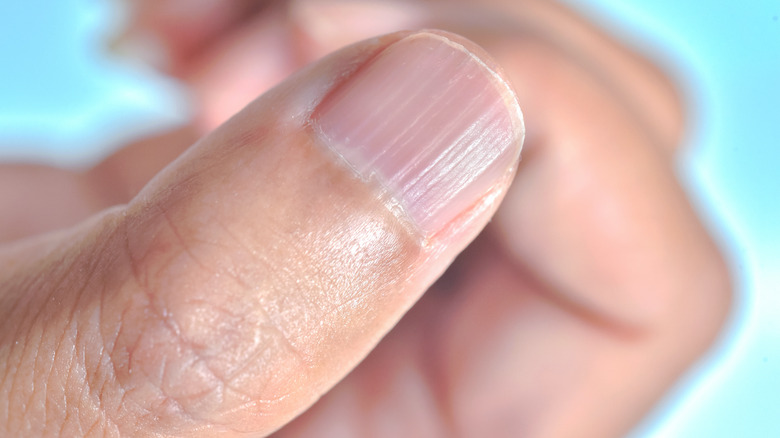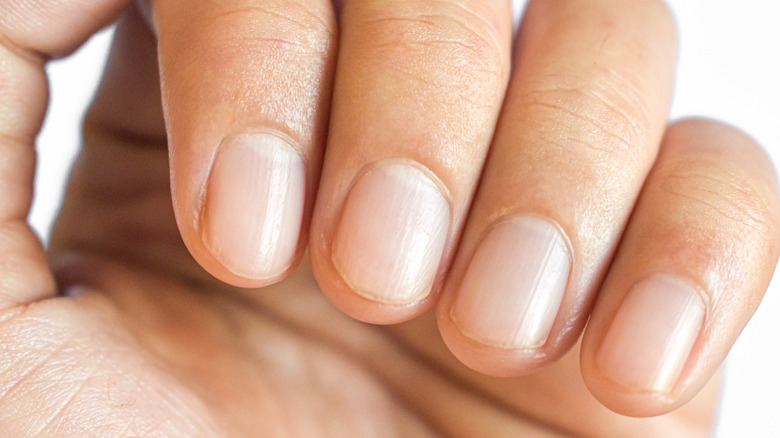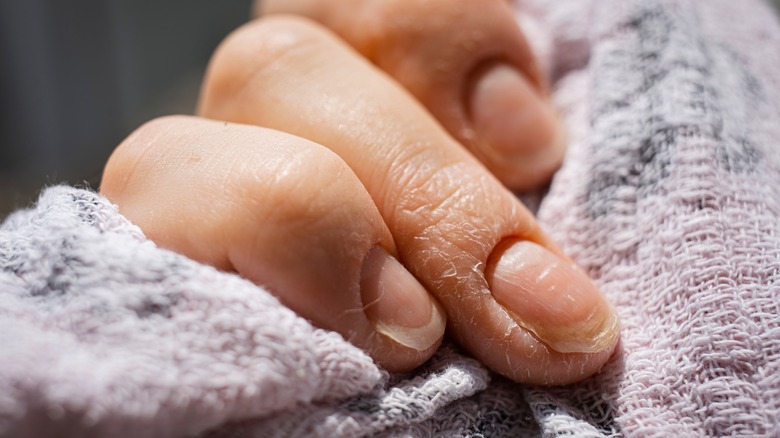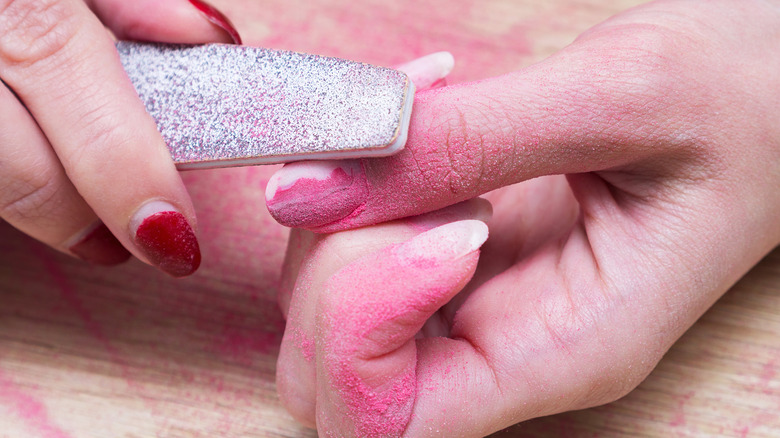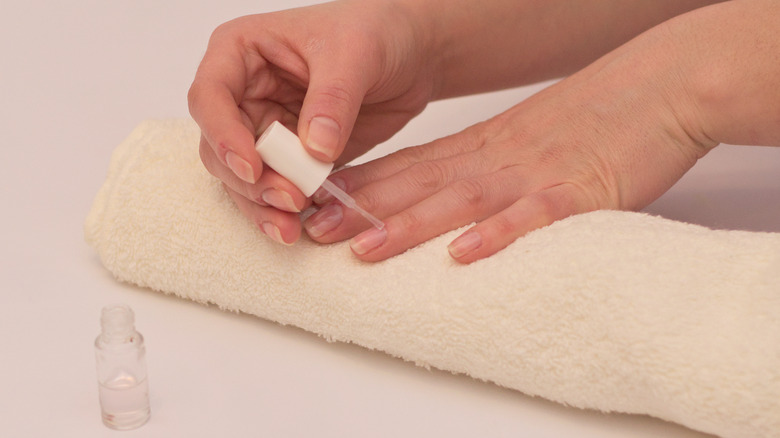Fingernail Ridges: Causes And Treatments For Vertical And Horizontal Nail Lines
Fingernail ridges are a thing, and while some ridges are more common than others, you may have one burning question on your mind: Are fingernail ridges a cause for concern? Most of the time, they're not. Our bodies change as we age, so your vertical nail ridges could be nothing more than a sign of growing older. "For the most part, [they just] mean that time has passed and your nails are changing," Mona Gohara, dermatologist and associate clinical professor at Yale, tells Allure.
However, there are some situations in which you may want to seek medical advice from your doctor. Since there are two main types of nail ridges — vertical and horizontal — there is no one-answer-fits-all when it comes to causes and treatment. While vertical nail ridges typically aren't a cause for concern, deep horizontal fingernail ridges may signal something a little more serious (via Healthline).
Apart from understanding what causes fingernail ridges, there may be some preventative measures you can take prior to developing ridges that lessen your chances of seeing them appear in the future. And if you already have fingernail ridges, there are also some things you can do to help prevent them from getting any worse.
What causes vertical fingernail ridges?
Vertical nail ridging, also called longitudinal nail ridging, is the most common type and looks like long ridges going from the top to the bottom of your fingernails. With this type of ridging, you could experience splits in your nails as well. These ridges are oftentimes harmless, but there could be an underlying health cause that needs to be looked at.
While aging is a common cause, some other causes of longitudinal ridges include brittle nail syndrome, thyroid issues, anemia, rheumatoid arthritis, and osteoarthritis, just to name a few (per WebMD). According to the Journal of the American Academy of Dermatology, brittle nail syndrome is more common in women. When mixed with nail ridges, this condition can cause a lot of pain in addition to nail breakage.
If you have brittle nails that are peeling, this could be another sign that you have an underlying issue causing nail problems. Yellowing nails, blue nails, nail pits, white lines, and even in-grown nails can all be part of the longitudinal ridging — and the more symptoms you have, the more important it will be to talk to your doctor. Keep in mind that not every nail may be affected by ridges — sometimes, it might only be one or two.
What causes horizontal fingernail ridges?
If the ridges you're experiencing on your nails are horizontal, they're called Beau's lines. Like the longitudinal lines, there are all sorts of things that can cause them. Anything that impacts the growth of your nails can cause these sorts of ridges, whether it's from an injury to your nails, an illness, or even a manicure, according to Healthline. Even stress can cause nail damage!
When it comes to injuries, it's generally damage to your nail matrix — where the nails grow from — that causes issues like ridging. Caring for your nail matrix is just one key to maintaining healthy-looking nails. Like longitudinal lines, health issues can also cause horizontal ridges. Per the Cleveland Clinic, if you're not eating a well-rounded and healthy diet, including zinc and protein, you may experience these lines as well.
Health issues and illnesses, long-term or not, that can increase your risk of developing Beau's lines include measles, mumps, a heart attack, pneumonia, and any illnesses that cause a high fever. Conditions like Raynaud's phenomenon, hyperthyroidism, and diabetes are also common causes. The newest culprit added to the list is COVID-19. "If you see Beau's lines and you had COVID-19 symptoms a month prior, then it's possible that it's related to COVID-19," Julia Carroll, a dermatologist at Compass Dermatology in Toronto, tells Verywell.
Can vitamin or mineral deficiencies cause nail ridges?
If a healthy diet has the potential to keep your nails healthy, then it makes sense that the right vitamins and minerals will also do the same for your body and fingernails. If you're experiencing nail ridges, it could be because of a deficit of some key vitamins, minerals, and nutrients.
"We see [vertical ridges], brittleness, and easy breaking [or] chipping a lot in people who have specifically iron deficiency anemia," Laura Purdy, board-certified family medicine physician, tells Women's Health. "Your nails need a proper amount of iron in your bloodstream to form properly." The Indian Journal of Dermatology, Venereology, and Leprology notes that a lack of zinc can also contribute to both vertical fingernail ridges and Beau's lines.
The best way to find out if you're suffering from any deficiencies is to talk to your doctor about scheduling a blood panel to look at your numbers. Once you see which minerals are low in your body, your doctor can suggest the right vitamins and supplements to take to help you out — and once you have dealt with your deficiencies, your nail ridges may start to improve.
How can damage cause nail ridges?
As mentioned, damage to your nails can cause ridges to occur — and it can even cause your nails to fall off. There are all kinds of ways your nails and nail matrix might experience damage that leaves behind nail ridges. But how can you damage your nails or nail matrix? One of the quickest ways is by improperly removing fake nails like acrylics.
If you're filing them off too deeply into your natural nails or you're attempting to just pull them off rather than soaking them, you could cause damage to your nails. Like celebrity nail artist Julie Kandalec told Makeup.com, "Like other nail enhancements, the damage comes from improper prep, application or most commonly, removal; aka the person doing them or removing them."
Even if you don't get fake nails, you can still cause damage to your nails. Nail trauma can happen when you drop something heavy on your finger or toe or even at the right angle. Picture this: You open the fridge to grab a soda, and one falls out and lands on your toe. It hurts like heck, bruises up, and before you know it, you're noticing a horizontal line on your toenail — that is a Beau's line.
Can skin problems and digestive disorders cause nail ridges?
The ridges on your nails could be tied to internal health issues affecting your gut or external ones that are affecting your skin. According to News Medical, skin conditions like lichen planus, Danier disease, alopecia, and psoriasis all have the potential to leave you with ridges on your nails.
Your nail ridges could also be telling you something is amiss internally, and it could be more than just a vitamin deficiency. If your body is not properly absorbing nutrients, you could notice it in your nails first.
According to Medical News Today, dietary issues, like celiac and Crohn's disease, can make your gut struggle to properly do its job, and "the skin and nails may suffer." Finding out what is causing malabsorption can help you change your diet. For example, if gluten is the culprit, taking vitamin supplements likely won't help unless you cut out gluten — and, in a case like this, talking to your doctor is the best bet.
When to see a doctor for fingernail ridges
If the ridges on your nails are new, seem to have changed, or started to crack, you may want to schedule an appointment with your doctor. If you have a skin issue, like psoriasis or alopecia, and you think your ridges may be a symptom of your condition, you could make an appointment with your dermatologist.
"If the condition is sudden in onset or causes splitting of the nail at the free edge, it would be beneficial to see your doctor," Amanda Zubek, medical director of Yale Medicine Dermatology in Middlebury, Connecticut, tells Prevention. "Your primary care doctor can screen for internal causes of ridging, or refer you to a dermatologist who can evaluate for skin conditions that might be causing it," Dr. Zubek adds
Depending on your insurance, getting a referral to a dermatologist from your primary care physician could be the best bet. By checking in with your doctor, you'll be able to find out if there are underlying issues causing your ridges and the ways you can deal with them, depending on what is leading to your bumpy nails.
How will your doctor diagnose the cause of your nail ridges?
Since there are all sorts of causes for nail ridges, and some differ between horizontal and vertical ridges, your doctor will most likely start by asking if you are experiencing any other symptoms. As MedlinePlus points out, they may also ask if you've had any recent injuries to your nails. They'll likely take a look at your medical history, as well. Since there are some medications that can cause lines in your nails, like chemotherapy treatments, your physician will also look into your medications.
Your doctor may order blood tests to find out if you're deficient in certain nutrients. They may test for digestive disorders, like celiac disease and IBD or IBS. They may also take X-rays to get an internal look at what's going on, often to check for damage to your nail or nail matrix. Once your doctor is able to figure out the cause of your nail ridges, they'll be able to give you some tips on how to treat them. With Beau's lines, as Cleveland Clinic points out, they may grow out over time (about six months), but there is no way to speed up the recovery of that type of nail ridges.
How to treat nail ridges from the inside
Once you know if you have any deficiencies, your doctor can suggest the right amounts of vitamins or supplements to take — but you can also work on bettering your diet so you can get some of those nutrients through what you're consuming in your meals. In addition to healthy meals, adding exercise to your routine can tackle nail ridges. "Regular cardiovascular activity will help with peripheral perfusion to the digits (blood flow) and help with ridging as well," dermatologist Dana Stern tells Byrdie.
Experts also caution against too much handwashing. "Washing your hands too often strips your skin of its natural oils and emollients, resulting in dryness and even hand eczema, which can cause nail changes," dermatologist Noelani González tells Prevention. One supplement created specifically for healthier hair, skin, and nails is biotin (vitamin B7).
You can take it on its own or find it in multivitamins. "Vitamin A, vitamin B, biotin, iron, and zinc are needed for normal growth of nails, but moderation of these vitamins is key," dermatologist Angela Kim tells Good Housekeeping. "Too much of one or more vitamins can lead to serious health issues." This is why it's important to first check with your doctor so they can run the appropriate blood tests to properly diagnose any deficiencies you might be experiencing.
How to treat nail ridges from the outside
There are things you can do on the outside to help heal and strengthen your nails, too, like strengthening polishes that help harden your nails. If the cause of your nail ridges is from your manicures, you may need to lay off the fake nails and ask for modifications when hitting the salon. When you do get a manicure, ask your nail technician to leave your cuticles alone. "The cuticle is the only barrier the fingers have to keep dirt and infection out of the tissues of the fingers," dermatologist Dr. Tsippora Shainhouse tells Byrdie. "Not only can infection cause damage to the nail matrix, but the actual pushing can bang it up, creating a permanent ridge template for all future nail growth."
Keeping your hands moisturized is also helpful. "Keeping your nails hydrated with a hand cream or oil can minimize the appearance of ridging and protect the keratin of the nail," board-certified dermatologist Donna Hart tells Prevention. Give your nails some extra love by keeping them clean and dry, using fewer damaging products, buffing them less, and, of course, not nibbling on them. While having nail ridges may be stressful, you can use ridge fillers and gentle nail polish (no gel or acrylic!) to help hide the visibility of your ridges while you work on caring for them in other ways.
How to prevent nail ridges
While some say that you can't really do anything to prevent ridges, especially ones that occur as we age, there are measures you can take to help keep ridges from coming along too soon or to avoid those horizontal Beau's lines. One piece of advice comes from dermatologist Karan Lal: "Some people go to salons and get their nails drilled and sanded, and I don't recommend doing that because if you have brittle nails they can actually make your nails thinner which can make them easier to crack" (via Prevention).
"Protecting the cuticles will protect your nail matrix stem cells so that your nails stay healthy and grow normally," Dr. Angela Kim tells Good Housekeeping. "It's really important for folks to not overdo your nails ... You don't have to always have a gel or a powder or a design on your nail. Give your nail a break from time to time and take care of them just like you take care of your body," dermatologist Saya Obayan adds,
Of course, doing what you can to not damage your nails or nail matrix is one way of prevention, but we want to encourage you to try this other healthy tip as well: Eat a healthy diet. Eating a balanced, healthy diet is one of the best ways to protect ourselves from a myriad of illnesses and health issues, including nail ridges. If vitamin deficiencies and illnesses can cause ridges, the right diet may prevent them.
